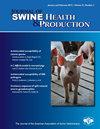Reduced vitamin supplementation with fat-soluble vitamins A, D, and E added at National Research Council requirements may not be adequate for optimal sow and progeny performance
IF 0.7
4区 农林科学
Q3 Agricultural and Biological Sciences
引用次数: 4
Abstract
Objective: To evaluate performance and physiological vitamin status of sows and progeny fed 2 vitamin supplementation levels, industry vs reduced (all vitamins reduced with fat-soluble vitamins added at National Research Council recommendations). Materials and methods: Sows (n = 244) were allotted in a randomized complete block design to 1 of 2 vitamin supplementation levels. At weaning, 765 progeny from a subset of sows were allotted to treatments in a 2 × 2 factorial arrangement of two sow and two nursery vitamin supplementation levels with 15 pens/treatment. Performance and vitamin status of sows and progeny were measured from farrowing to nursery exit. Results: Reduced vitamin supplementation reduced sow lactation feed intake (P = .01), hepatic vitamin A (P = .001), and serum vitamin D (P < .001), but did not affect sow body weight or litter performance. Regardless of vitamin levels fed to the sow, progeny fed reduced levels post weaning had decreased circulating (P < .001) and stored (P = .03) vitamin levels and a reduction in average daily gain (P < .001), average daily feed intake (P < .001), gain:feed ratio (P = .002), and body weight (P < .001) at the end of the nursery period compared to progeny fed industry levels. Implications: Reduced vitamin supplementation reduced sow feed intake without affecting sow or litter performance, but decreased circulating and stored vitamin levels in sows could impact long-term reproductive performance. Reduced vitamin inclusion levels in nursery diets reduced performance and serum vitamin concentrations compared to industry vitamin levels.根据国家研究委员会的要求,减少脂溶性维生素A、D和E的补充可能不足以达到最佳的母猪和后代性能
目的:评估饲喂2种维生素补充水平的母猪及其后代的性能和生理维生素状况,工业维生素与减少维生素(根据国家研究委员会的建议,添加脂溶性维生素可减少所有维生素)。材料和方法:母猪(n=244)在随机完全区组设计中被分配到2个维生素补充水平中的1个。断奶时,来自一个子集母猪的765个后代被分配到2×2析因安排的处理中,两头母猪和两个苗圃的维生素补充水平为15笔/处理。测量母猪及其后代从产仔到育婴的生产性能和维生素状况。结果:维生素补充减少降低了母猪泌乳期的采食量(P=.01)、肝脏维生素A(P=.001)和血清维生素D(P<.001),但不影响母猪的体重或产仔性能。无论喂给母猪的维生素水平如何,与喂给后代的工业水平相比,断奶后喂给水平降低的后代在育婴期结束时循环(P<.001)和储存(P=.03)维生素水平降低,平均日增重(P<0.001)、平均日采食量(P<001)、增重与饲料比(P=.002)和体重(P<.001)降低。影响:维生素补充减少减少了母猪的采食量,但不会影响母猪或产仔的性能,但母猪循环和储存的维生素水平降低可能会影响长期繁殖性能。与工业维生素水平相比,幼儿园饮食中维生素含量的降低降低了表现和血清维生素浓度。
本文章由计算机程序翻译,如有差异,请以英文原文为准。
求助全文
约1分钟内获得全文
求助全文
来源期刊
CiteScore
1.80
自引率
0.00%
发文量
29
审稿时长
>36 weeks
期刊介绍:
The Journal of Swine Health & Production (JSHAP) is an open-access and peer-reviewed journal published by the American Association of Swine Veterinarians (AASV) since 1993. The aim of the journal is the timely publication of peer-reviewed papers with a scope that encompasses the many domains of applied swine health and production, including the diagnosis, treatment, management, prevention and eradication of swine diseases, welfare & behavior, nutrition, public health, epidemiology, food safety, biosecurity, pharmaceuticals, antimicrobial use and resistance, reproduction, growth, systems flow, economics, and facility design. The journal provides a platform for researchers, veterinary practitioners, academics, and students to share their work with an international audience. The journal publishes information that contains an applied and practical focus and presents scientific information that is accessible to the busy veterinary practitioner as well as to the research and academic community. Hence, manuscripts with an applied focus are considered for publication, and the journal publishes original research, brief communications, case reports/series, literature reviews, commentaries, diagnostic notes, production tools, and practice tips. All manuscripts submitted to the Journal of Swine Health & Production are peer-reviewed.

 求助内容:
求助内容: 应助结果提醒方式:
应助结果提醒方式:


